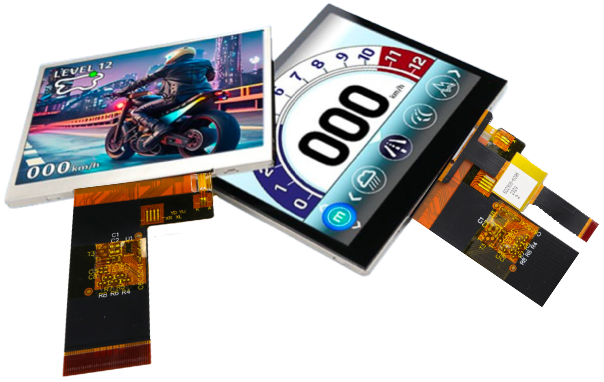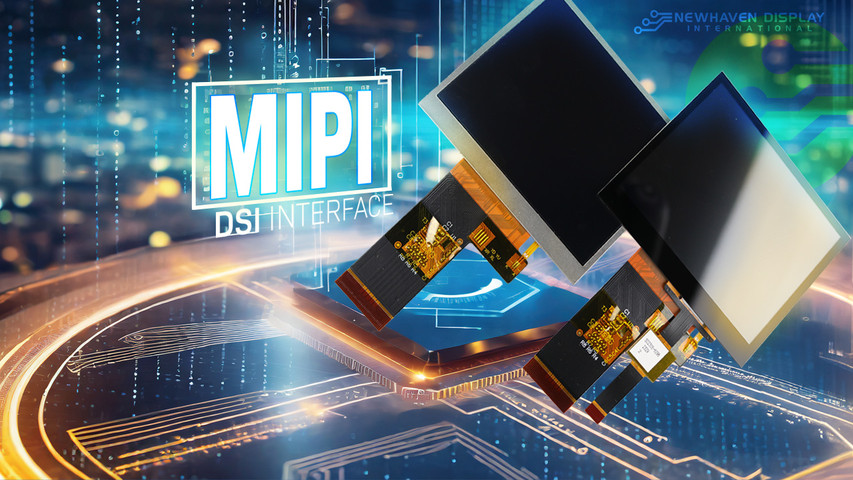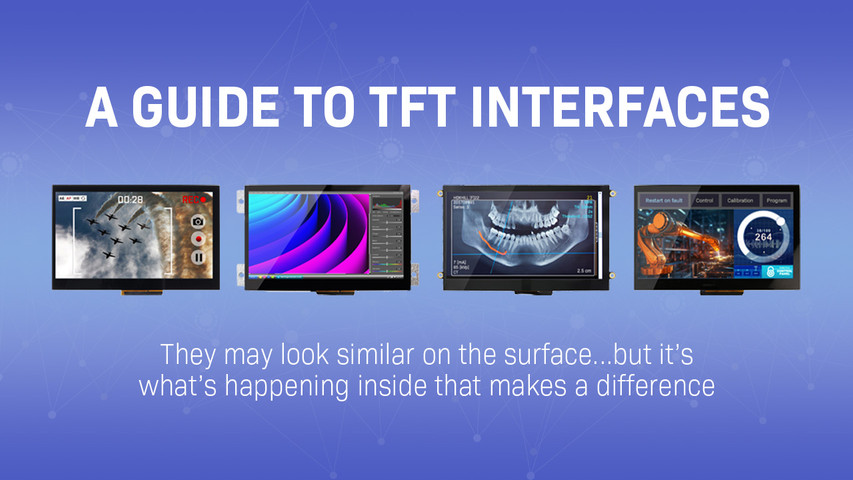MIPI DSI Interface
Imagine a world where devices communicate seamlessly and efficiently, especially with mobile high-resolution displays such as mobile phones, handheld gaming consoles, tablets, and beyond. This is the promise of MIPI (Mobile Industry Processor Interface), a revolutionary communication standard for mobile and other high-end electronics.
In this article, we will focus primarily on the MIPI DSI (Display Serial Interface), a key component of the MIPI standard that plays a crucial role in the world of mobile display technology.
En este artículo:
Understanding The MIPI Interface
What is MIPI
MIPI (Mobile Industry Processor Interface) is a set of standardized specifications for data communication interfaces in mobile devices such as mobile phones, cameras, electronic displays, embedded systems, radios, IoT devices, and many other components that require high bandwidth, low power consumption, and low electromagnetic interference.
MIPI was developed in 2003 by the MIPI Alliance formed by industry leaders Arm, Intel, Nokia, Samsung, STMicroelectronics, and Texas Instruments to ensure compatibility, reduce complexity, enable seamless integration of different components, and enhance design efficiency.
Key Characteristics of MIPI
- Standardization: Provides universally accepted standards for various mobile components, promoting compatibility and ease of integration.
- Versatility: Applicable to a wide range of mobile device components.
- Efficiency: Aims to optimize power usage and data transfer rates, crucial for mobile device performance.
- Scalability: MIPI interfaces and specifications are designed to be scalable, allowing them to be adapted to various mobile device designs and accommodate future technological advancements.
What is MIPI DSI
MIPI DSI (Display Serial Interface) is a specific subset of MIPI standards focused on the interface between display modules and processors in mobile devices. It enables high-speed data transfer (up to 6 Gbps), which is essential for high-resolution, lag-free visuals on pixel-dense screens such as modern smartphones, tablets, portable gaming consoles, and other portable devices.
Learn more: Serial vs Parallel Communication
MIPI DSI supports popular display formats such as RGB-565, RGB-666, and RGB-888, catering to various color depths and pixel formats. This flexibility allows developers to fine-tune display performance based on specific needs, whether maximizing color accuracy with RGB-888 or prioritizing efficiency with RGB-565.
Additionally, MIPI DSI's energy efficiency helps extend battery life, while its standardization ensures compatibility across various devices. This interface also minimizes electromagnetic interference and supports multiple data lanes for greater bandwidth, crucial for advanced, high-resolution displays.
MIPI DSI is part of the MIPI standard and works to optimize communication between the processor and display to improve the performance of mobile devices.
Advantages of MIPI DSI
- High-Speed Data Transfer: Supports data transfer rates of up to 6 Gbps, enabling the display of high-resolution images and videos without lag - This is crucial for modern devices with increasingly pixel-dense screens.
- Differential Signaling: This reduces electromagnetic interference, ensuring a more stable and clearer display output, which is crucial for high-quality video and image display.
- Low Power Consumption: MIPI DSI is optimized to be energy efficient, minimizing power consumption and extending battery life - This is especially important for mobile devices, where battery life is a major concern.
- Low Electromagnetic Interference (EMI): MIPI DSI is designed to minimize electromagnetic interference, ensuring reliable data communication and preventing interference between display panels and other electronic components.
- Multi-Lane Support: MIPI DSI supports multiple data lanes, which allows for even higher data transfer rates and greater bandwidth. This is beneficial for devices with high-resolution displays.
- Error Detection and Correction: MIPI DSI includes built-in error detection and correction mechanisms, ensuring reliable data transmission and minimizing errors. This is important for maintaining image quality and preventing display artifacts.
- Scalability and Flexibility: Supports a range of display resolutions and can adapt to various screen sizes and technologies - This makes it a versatile solution for various mobile devices and screen sizes.
- Standardization: MIPI DSI is a standardized interface, ensuring compatibility between different devices and components. This standardization streamlines the process for manufacturers in designing and developing display technologies that incorporate MIPI DSI.
- Support for Multiple Display Technologies: MIPI DSI is compatible with various display technologies, including OLED, LCD, and others, offering versatility in design choices.
Learn more: OLED vs LCD
Unleash Visual Power with MIPI DSI Displays
Explore our IPS TFT displays with 4-lane MIPI DSI Interface.
Más información
MIPI DSI Technical Overview
MIPI DSI Power Interface Levels
MIPI DSI interfaces utilize different voltage levels for signal transmission, catering to varied operational demands. These levels are differentiated into High-Speed Mode, Low-Power Mode, and Ultra Low-Power Mode, each serving distinct purposes:
High-Speed Mode
- High-Speed Mode is designed for actively displaying content with high refresh rates and resolutions.
- Both data lanes and backlight are fully operational.
- Ideal for demanding applications like video streaming and gaming.
- In this mode, data transfer rates can reach up to 6 Gbps, ensuring smooth and responsive visuals. This is particularly important for high-definition content and fast-refresh displays.
- While offering superior performance, High-Speed Mode consumes more power than Low-Power Mode, making it less suitable for energy-saving operations.
Low-Power Mode
- This mode is designed for situations where the display is idle for short periods of time. In this mode, the data lanes are turned off, but the backlight remains on.
- Optimizes energy efficiency, crucial for battery-powered devices like smartphones and wearables.
- This mode reduces data transfer rates compared to High-Speed Mode but still maintains acceptable performance for basic tasks such as displaying static images or low-intensity animations.
- Significantly extends battery life by minimizing power consumption, especially beneficial in situations where display content is static or less demanding.
Ultra Low-Power Mode
- Ultra-low power mode is designed for situations where the display is idle for extended periods of time.
- In this mode, both the data lanes and the backlight are turned off. This can reduce power consumption by up to 90%.
- Less power consumption translates to less heat generation. This can improve the overall thermal performance of the device, leading to longer lifespan and better reliability.
These interface levels in MIPI DSI enable devices to balance between high performance and energy efficiency, adapting to different usage scenarios and power management requirements.
Learn more: RS232 Standard
MIPI DSI Data Packet Levels
The MIPI DSI interface operates using two primary types of packets: short packets and long packets. Each serves a specific purpose and offers distinct benefits depending on the data being transmitted.
Short Packets
- Used for sending commands requiring minimal data, such as brightness adjustments, color inversion, and display sleep/wake.
- Typically between 2 to 9 bytes in length.
- Efficient for controlling basic functions.
- Packet ends with an 8-bit error correction code (ECC).
Long Packets
- Used for transmitting image data and commands containing multiple bytes.
- Range from 6 to 65,541 bytes of data.
- Essential for displaying complex images and videos.
- Packet ends with a 16-bit checksum.
MIPI DSI Operating Modes
MIPI DSI operates in two primary modes: Command Mode and Video Mode. The Command Mode is designed for low-power operations, where the display receives commands and data in a packet-based format. This mode is ideal for scenarios where frequent screen updates are not necessary, thus conserving power. In contrast, Video Mode is optimized for streaming large volumes of data, making it suitable for high-resolution and high-refresh-rate displays. It continuously transmits pixel data, ensuring smooth video playback and dynamic content display.
Command Mode
- Used to send control commands to the display, including setting display parameters, adjusting image quality, and managing power states.
- Similar to other display interface commands like SPI and I2C.
- Allows for precise control over display functions.
Video Mode
- Used to send a continuous stream of image data to the display for real-time playback.
- Requires a constant flow of data from the processor to maintain image quality.
- Offers a smoother and more responsive viewing experience for videos and animations.
Learn more: OLEDs in Wearable Devices
Conclusión
MIPI DSI has revolutionized mobile display communication, enabling stunning visuals, responsive touch interfaces, and energy-efficient operation. The combination of high-speed data transfer, scalability, and optimized power consumption makes MIPI DSI the ideal choice for product developers, ensuring a seamless and enjoyable mobile experience.
Últimas entradas del blog
-
A Guide to TFT Display Interfaces
Display interfaces often get less attention than screen resolution or brightness, but they carry jus …Dec 16th 2025 -
Choosing the Right Display Resolution: A User-Friendly Guide
Display resolution is one of the most defining choices in product interface design. It determines ho …Dec 11th 2025 -
Arduino vs Raspberry Pi vs BeagleBone: Key Features and Differences
If you're working on an electronics project—whether it's for a DIY automated device, a digital sign, …Dec 8th 2025





